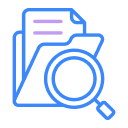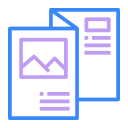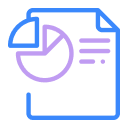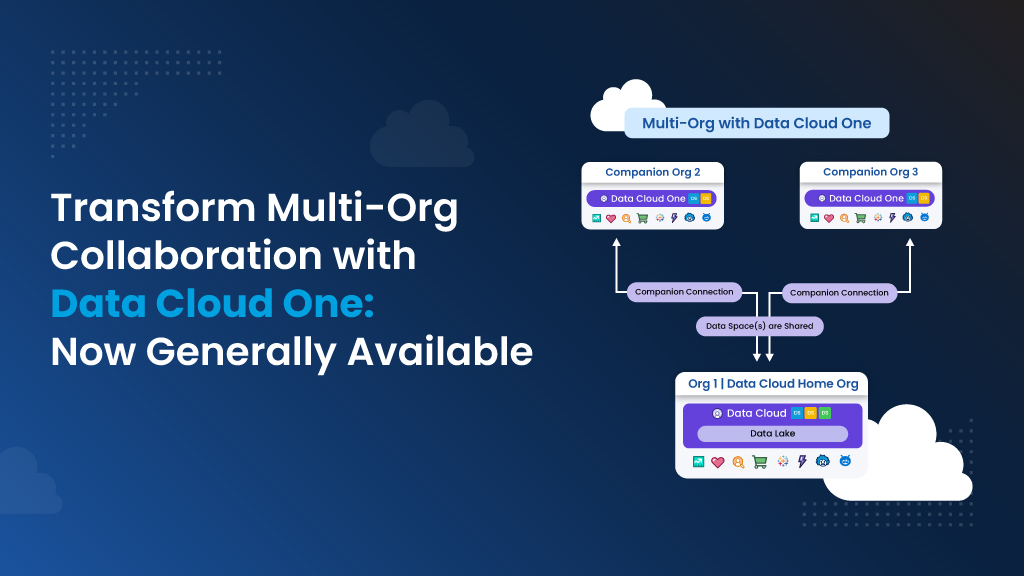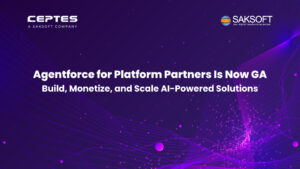Managing data across multiple Salesforce orgs has always been a complex task. Teams with multiple Salesforce orgs, whether due to business divisions or acquisitions, have long wished for a seamless way to unify their customer data and enhance collaboration. That wish is now a reality with the launch of Data Cloud One, a revolutionary feature that allows multiple orgs to access a unified Customer 360, powered by a single, central Data Cloud.
Why do companies have multiple
Salesforce orgs?
Companies often have multiple Salesforce orgs for various reasons. A company could have different Salesforce orgs for distinct business units, brands or regions. Each unit might use its own org to manage customer data, products, and sales processes. Or, they can inherit them as part of acquisition. In case of acquisition, the new business might already have its own Salesforce org.
For example, if a healthcare company buys a smaller clinic network, the clinic might use a different Salesforce org for managing patient data. Integrating that org with the parent company’s Salesforce systems could be a complex process.
In both cases, Data Cloud One allows businesses to easily connect multiple orgs, share data, and leverage Data Cloud features without the hassle of complex integrations. This results in more effective collaboration and a consistent customer experience across the entire organization.
Let’s dive into how Data Cloud One is simplifying the lives of multi-org users and transforming the way businesses handle data.
Let’s Understand: What is Data Cloud One?
Data Cloud One is Salesforce’s latest offering that enhances multi-org development by giving organizations a unified customer profile through a single Data Cloud. Instead of provisioning Data Cloud separately for each org, you can now connect several orgs to a central “home org” via a companion connection and share customer data seamlessly across your organization.
Standard Salesforce CRM connections allow you to bring data from multiple orgs into the Data Cloud, where it’s centralized in the main “home org.” However, connected orgs can’t directly access this unified data. To use it in those orgs, you either need to trigger flows via data actions or build complex custom-coded solutions. Alternatively, you’d need to set up and maintain a separate Data Cloud for each org, which can be both time-consuming and expensive!
Data Cloud One makes it easy to access a single Data Cloud across multiple orgs. Orgs linked through a companion connection are called companion orgs. In addition to standard data connections, users in these orgs can access key Data Cloud features via the Data Cloud One app. They can view unified customer profiles, create custom flows using the data, access calculated insights, and enhance business processes by integrating Data Cloud with CRM features.
This means that teams using different Salesforce orgs can have access to the same data in real time, without the hassle of syncing or transferring data.

Key Features of Data Cloud One
Data Cloud One comes packed with features that empower multi-org teams to work smarter, not harder. Here’s what makes it special:
- Unified Customer 360: Access a complete view of your customer across all your Salesforce orgs through one central Data Cloud.
- No-Code Setup: Share Data Cloud data with multiple Salesforce orgs through simple, point-and-click solutions. No need to write custom code or spend weeks configuring connections.
- Seamless Data Sharing: Enable companion orgs to access and act on customer data in real-time, using AI, automation, and CRM enrichments.
- Fast Implementation: Get started in minutes, not weeks. Connect companion orgs to the home org with just a few clicks and start leveraging shared metadata instantly.
Why is Data Cloud One a Game-Changer for Businesses?
For organizations managing multiple Salesforce orgs, Data Cloud One isn’t just a convenience—it’s a breakthrough. Here are some examples of how it can revolutionize businesses:
- Simplified Data Access: Orgs with standard connection, connecting data across orgs has been a cumbersome task involving custom code, app configurations, and time-consuming data transfers. With Data Cloud One companion connection, it’s easy to access the Data Cloud metadata, objects, and records in shared data spaces.
- Real-Time Collaboration: Teams can now collaborate across orgs without the need for constant data synchronization. Whether it’s for marketing campaigns, customer support, or sales outreach, having a unified customer profile accessible means all departments are on the same page, making cross-functional collaboration more efficient.
- Cost Savings: Maintaining separate Data Cloud setups for each org not only adds complexity but also increases costs. Data Cloud One eliminates the need for duplicate infrastructure, reducing operational costs and saving time.
- AI and Automation at Scale: Data Cloud One allows every org in your company to benefit from AI-powered insights and automation, all from a single, centralized Data Cloud. This means faster response times, smarter customer interactions, and a more personalized customer experience across the board.
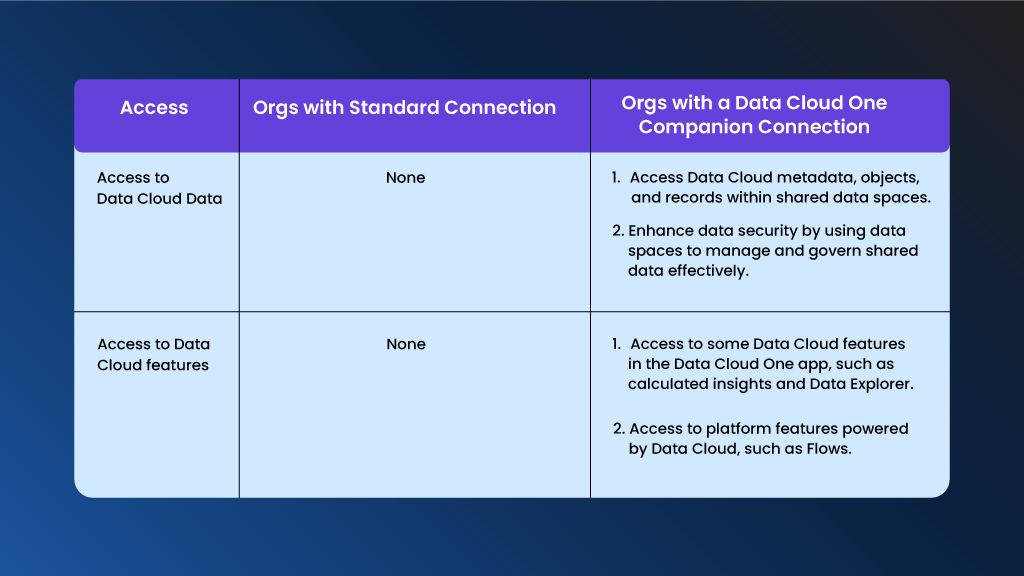
Use Case: Retail Banking Meets Insurance
Let’s say you manage a financial services company with separate orgs for retail banking, wealth management, and insurance. Previously, if your insurance team needed to access customer data from the retail banking org, they’d have to set up complex integrations. It could take weeks of coordination between teams, including coding, data transfers, and testing.
With Data Cloud One, that’s all history. Now, your insurance sales team can tap into customer data from the retail banking org instantly. Since metadata is shared across org, the sales team can gain direct, native access to the data cloud data in the retail banking org and get a single view of their customer. Now, they are empowered to create calculated insights or use CRM enrichments to enrich their CRM objectives easily.
This enables them to provide better, more personalized services to their clients—all while eliminating the usual technical headaches.
Getting Started with Data Cloud One
Accessing Data Cloud One is simple. Through Data Cloud Setup, you can activate three free companion connections, allowing you to connect to three other Salesforce orgs. A quick authentication process lets you choose which data to share with each companion org, giving you full control over what information is accessible.
The process is quick, low-code, and designed to make your team more productive right away.
Wrapping Up:
In conclusion, Data Cloud One brings unprecedented simplicity and power to organizations with multiple Salesforce orgs. By centralizing customer data and offering real-time access to AI-driven insights, it empowers teams to work faster, smarter, and more collaboratively.
Get started with Data Cloud One today. For consultation, reach us at contact@ceptes.com.
FAQs
1. How does Data Cloud One differ from traditional multi-org data sharing?
2. Can I choose what data to share between orgs?
3. Do I need to be a developer to set up Data Cloud One?
4. How fast can I implement Data Cloud One?
5. How many orgs can I connect to a single Data Cloud?

Nilamani Das
Nilamani is a thought leader who champions the integration of AI, Data, CRM and Trust to craft impactful marketing strategies. He carries 25+ years of expertise in the technology industry with expertise in Go-to-Market Strategy, Marketing, Digital Transformation, Vision Development and Business Innovation.


